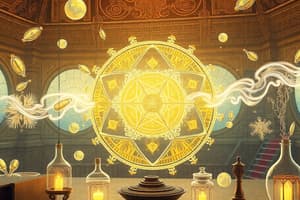Podcast
Questions and Answers
When was the idea of an atom first developed?
When was the idea of an atom first developed?
John Dalton, 1803.
The 4 major ideas of Dalton's Atomic Theory are: 1. Matter is made up with atoms that are invisible and indestructible, 2. All atoms of an element are __________.
The 4 major ideas of Dalton's Atomic Theory are: 1. Matter is made up with atoms that are invisible and indestructible, 2. All atoms of an element are __________.
identical
Atoms of different elements have different __________ and different chemical properties.
Atoms of different elements have different __________ and different chemical properties.
weights
Atoms of different elements combine in simple whole numbers to form __________.
Atoms of different elements combine in simple whole numbers to form __________.
Describe the experiment that led to the discovery of the electron. Who discovered it?
Describe the experiment that led to the discovery of the electron. Who discovered it?
Describe Rutherford's gold foil experiment. What did this experiment tell us about the structure of the atom?
Describe Rutherford's gold foil experiment. What did this experiment tell us about the structure of the atom?
What are the 3 subatomic particles?
What are the 3 subatomic particles?
Who discovered the neutron?
Who discovered the neutron?
Who determined the charge of the electron and during what experiment?
Who determined the charge of the electron and during what experiment?
Describe the Electron Cloud Model of the atom. What are the smallest parts of an atom we know today?
Describe the Electron Cloud Model of the atom. What are the smallest parts of an atom we know today?
What does the atomic number of an element represent? What does the mass number of an atom represent?
What does the atomic number of an element represent? What does the mass number of an atom represent?
What are isotopes? How are they similar to each other? How are they different?
What are isotopes? How are they similar to each other? How are they different?
What does the atomic mass of an element represent?
What does the atomic mass of an element represent?
Of protons, neutrons, and electrons, which of these can never change in an atom during an ordinary chemical or physical change? Explain why.
Of protons, neutrons, and electrons, which of these can never change in an atom during an ordinary chemical or physical change? Explain why.
What is an ion? What are the two ways in which an ion can be made?
What is an ion? What are the two ways in which an ion can be made?
Study Notes
Historical Development of Atomic Theory
- The concept of the atom originated with John Dalton in 1803.
Dalton's Atomic Theory
- Matter consists of indivisible and indestructible atoms.
- Atoms of a single element are identical in mass and properties.
- Different elements have distinct atomic weights and chemical properties.
- Atoms combine in simple whole-number ratios to create compounds.
Discovery of the Electron
- Joseph John "J.J." Thomson discovered the electron in 1897.
- The discovery stemmed from experiments using Crookes tubes and cathode rays, revealing that cathode rays are negatively charged.
Rutherford's Gold Foil Experiment
- Conducted by Ernest Rutherford, alpha particles were directed at a thin gold foil.
- The experiment led to the conclusion that atoms possess a small, dense nucleus responsible for particle deflections.
Subatomic Particles
- The three fundamental subatomic particles are:
- Proton
- Neutron
- Electron
Discovery of the Neutron
- The neutron was discovered by James Chadwick.
Determining Electron Charge
- Robert A. Millikan determined the charge of the electron through the Oil Drop Experiment.
Electron Cloud Model
- The electron cloud model depicts electrons surrounding a nucleus made up of protons and neutrons.
- Key components of an atom include:
- Electrons
- Protons
- Neutrons
Atomic Number and Mass Number
- The atomic number signifies the number of protons and is unique to each element.
- The mass number is the total of protons and neutrons in the nucleus.
Isotopes
- Isotopes are variants of elements that have the same number of protons but differ in neutrons.
- They maintain identical chemical properties due to the same proton count.
Atomic Mass
- The atomic mass reflects the combined number of protons and neutrons within an element.
Stability of Protons
- Protons remain unchanged during ordinary chemical or physical changes; altering the proton count changes the element itself.
Ions
- Ions are charged atoms formed by the loss or gain of electrons.
- Two methods of ion formation include:
- Losing an electron (positive ion or cation)
- Gaining an electron (negative ion or anion)
Studying That Suits You
Use AI to generate personalized quizzes and flashcards to suit your learning preferences.
Description
Explore the historical development of atomic theory from John Dalton's initial concepts to J.J. Thomson's discovery of the electron and Rutherford's experiments. Understand the characteristics of atoms and subatomic particles including protons, neutrons, and electrons through this quiz.




